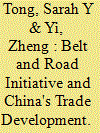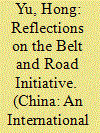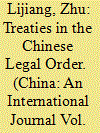|
|
|
Sort Order |
|
|
|
Items / Page
|
|
|
|
|
|
|
| Srl | Item |
| 1 |
ID:
170383


|
|
|
|
|
| Summary/Abstract |
It has been over six years since the idea of the Belt and Road Initiative (BRI) was first publicised. While the importance of BRI has been widely recognised, its impacts are wide-ranging and controversial. This article, by first reviewing existing studies, is a preliminary effort to assess the BRI's effect on China's trade development. The authors' analysis indicates that, six years after the initiative's implementation, the changes in China's trade relations with countries along the Belt and Road are limited, compared to those with other countries. Data has also shown that there are huge variations across regions within the Belt and Road countries in their trade relations with China. More in-depth studies are needed to enhance our understanding of the BRI's overall impacts.
|
|
|
|
|
|
|
|
|
|
|
|
|
|
|
|
| 2 |
ID:
170381


|
|
|
|
|
| Summary/Abstract |
The "One Belt, One Road" (OBOR) initiative—Chinese President Xi Jinping's signature project and strategic master plan that promotes infrastructure connectivity with foreign countries—has been widely discussed in academia and the media since its launch in 2013. The OBOR's engagement in Southeast Asia is evident in terms of infrastructure development projects, economic and trade cooperation zones, port construction and industrial cooperation. This article explains the role Southeast Asia plays in the progress of the OBOR (now commonly known as the Belt and Road Initiative [BRI]) projects, which are also aligned with the ASEAN (Association of Southeast Asian Nations) connectivity master plan and domestic policies of individual ASEAN countries. Southeast Asia's significance in the BRI's development could be viewed from the following aspects: the geoeconomics and geopolitical consideration in the region, as well as the contribution to potential growth of China's internal industrial and economic development. However, China should review its model of investment—in terms of the nature of projects, form of cooperation and the domestic political development of ASEAN countries—as Southeast Asian countries have found Chinese practices and motivations questionable.
|
|
|
|
|
|
|
|
|
|
|
|
|
|
|
|
| 3 |
ID:
170385


|
|
|
|
|
| Summary/Abstract |
With the revival of the historical trade routes across the Eurasia and along its coasts, Europe finds itself at the receiving end of a major Chinese foreign policy strategy. There is no doubt that the Chinese leadership and many observers believe that the Belt and Road Initiative would contribute significantly to economic growth and interaction across Eurasia. In Europe, the initiative has prompted a range of different reactions, from a strong embrace of the opportunities for increased mutual trade and investment on the one hand, to scepticism about the feasibility or political implications of the project on the other. This article will provide a survey of the debate witnessed in Europe to date.
|
|
|
|
|
|
|
|
|
|
|
|
|
|
|
|
| 4 |
ID:
170389


|
|
|
|
|
| Summary/Abstract |
How do ordinary people in China obtain adequate information to safely petition the government? And how does the government acquire information to monitor petitioners? This article argues that petition brokers are the go-betweens who provide information to both parties. During normal times, petition brokers are the agents of petitioners, helping them to seek redress. During politically sensitive times, petition brokers are "bought off" by the government—i.e. they provide the government with information on petitioners and also assist in monitoring petitioners. The brokers' role has therefore created a principal–agent problem. However, findings in this article have shown that the said activities of petition brokers may be conducive to the maintenance of social stability and political control in China.
|
|
|
|
|
|
|
|
|
|
|
|
|
|
|
|
| 5 |
ID:
170387


|
|
|
|
|
| Summary/Abstract |
Although the rise of localism in Hong Kong has generated a large body of literature, an overarching definition of this new political force is still lacking. Based on analyses of organisations' documents, media reports and interviews with activists, this article argues that localist groups can be defined as groups that share a combination of three core ideological features: regionalism, radicalism and populism, and an origin in centre–peripheral conflicts between mainland China and Hong Kong. Given this definition, localism can be conceptualised as a kind of "populist radical regionalism". The implications of this definition will be discussed in this article.
|
|
|
|
|
|
|
|
|
|
|
|
|
|
|
|
| 6 |
ID:
170386


|
|
|
|
|
| Summary/Abstract |
China's Belt and Road Initiative has been presented as a "win-win" opportunity, as countries involved would benefit from connectivity projects of mutual interest. As such, it should facilitate and improve the relationship between the European Union (EU) and China, long defined as a "strategic partnership". Instead, this article argues that the BRI—as an order-shaping exercise—has put the partnership under strain, enlarging the gap between a "win-win" rhetoric and the reality of frictions and contestations. By analysing the official discourse in EU documents, and comparing them with the dynamics that the BRI has been generating, especially in Central Europe and in the Western Balkans, the author comes to the conclusion that the EU–China relationship does not pass the test of a "strategic partnership", as defined in the literature. Thus, in order to reduce the possibility of increasing misunderstandings and growing suspicion, and to prevent a "lose-lose" final outcome—a common destiny that the international community should avoid—the way forward for the EU and China is to explore and discuss effectively what type of operational principles could sustain the partnership.
|
|
|
|
|
|
|
|
|
|
|
|
|
|
|
|
| 7 |
ID:
170384


|
|
|
|
|
| Summary/Abstract |
This article provides an analysis of China's energy cooperation with Central Asia in the context of competition between geopolitical actors. Using historical narrative analysis methods to unfold the dynamics of the interactions between the actors, the author presents a case study of Kazakhstan's energy industry. This study could offer broader implications as the country attracted the lion's share of foreign direct investment in Central Asia, including investment from China within the Belt and Road Initiative. The analysis suggests that Central Asian states benefited from the competition between global actors as they diversified their export routes, which strengthened their political and economic independence. In the end, Central Asian states and energy consumers developed energy cooperation networks in the same area where the ancient Silk Road crossed the Eurasian landmass. Concerning the theoretical implications, this article highlights to the usefulness of applying both realist and liberal frameworks of international relations theory in tandem.
|
|
|
|
|
|
|
|
|
|
|
|
|
|
|
|
| 8 |
ID:
170379


|
|
|
| 9 |
ID:
170380


|
|
|
|
|
| Summary/Abstract |
The grand "Belt and Road Initiative" (BRI), comprising various routes by land and by sea, is a globally oriented outreach strategy intended to connect China with the world. Essentially, the BRI is about global outreach, connecting the world with China as the core hub. The initiative is known in Chinese as "Yi Dai Yi Lu" ("One Belt, One Road") but in practice, it encompasses multiple routes along the BRI, connecting various specific countries and regions, transportation modes and industrial sectors. China has the financial resources, the technology, the manpower, and most importantly, the political will and strategic vision to support infrastructure development in developing countries. Nevertheless, the BRI is currently at a crossroads. The tremendous enthusiasm for the promise of increased infrastructure connectivity and trade promotion under this initiative has begun to subside. Indeed, the implementation of the BRI has faced various practical issues and serious challenges.
|
|
|
|
|
|
|
|
|
|
|
|
|
|
|
|
| 10 |
ID:
170382


|
|
|
|
|
| Summary/Abstract |
This article discusses the role of Singapore in the Belt and Road Initiative (BRI) and its efforts to add value to and complement China's forays into the BRI region. Although Singapore does not have any major BRI-related infrastructure projects on its shores, it is an important regional financing hub and plays a pivotal role as a gateway to the Southeast Asia region, which is a key part of the Maritime Silk Road. Singapore possesses an outstanding business environment that enables it to facilitate investments into Southeast Asia, into which many BRI-related investments are flowing.
|
|
|
|
|
|
|
|
|
|
|
|
|
|
|
|
| 11 |
ID:
170388


|
|
|
|
|
| Summary/Abstract |
The academic discourse on the rank of duly concluded treaties (DCTs) in the Chinese legal order has been in chaos for decades due to the lack of a uniform provision in the Constitution, the diversity and even contradiction of treaty-related articles (TRAs) in ordinary laws. Recent noticeable developments have occurred in Chinese legislation and judicial practice. These include the gradual deletion of TRAs in many ordinary laws, the impact of the "Belt and Road Initiative" upon the application of international economic and commercial treaties, and the diversity of application of DCTs in the courts. Although Chinese scholars have proposed to standardise the rank of DCTs in the Constitution, the amendment to the Constitution in 2018 has failed to positively respond to the proposal.
|
|
|
|
|
|
|
|
|
|
|
|
|
|
|
|
|
|
|
|
|